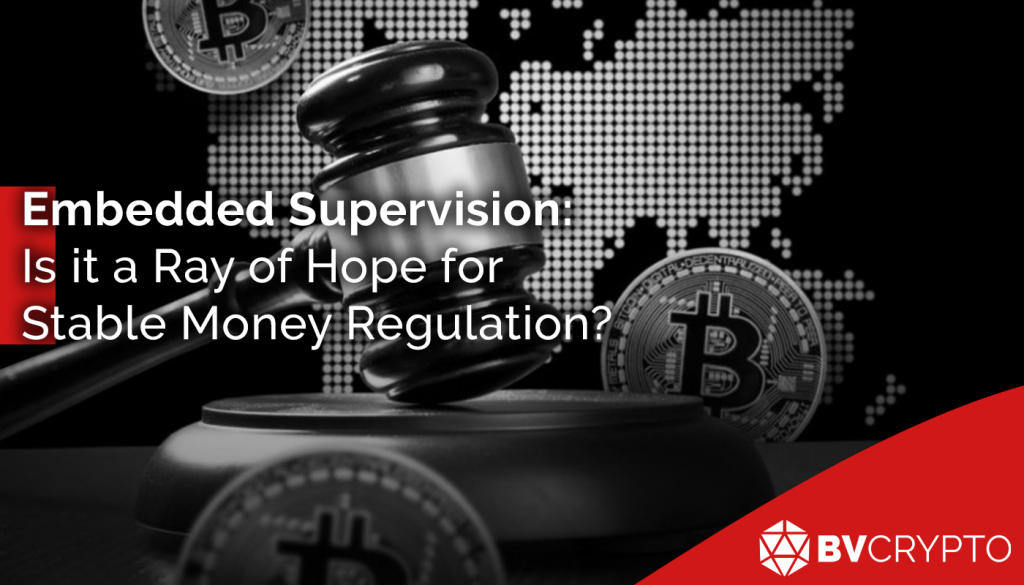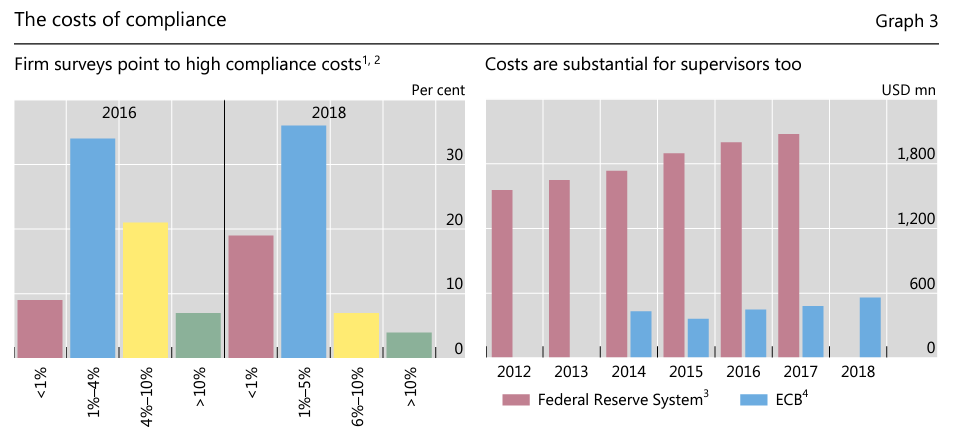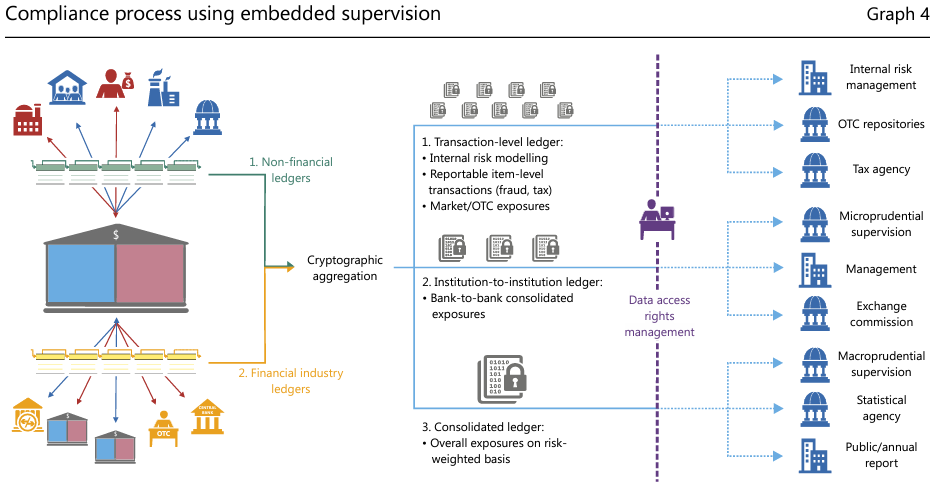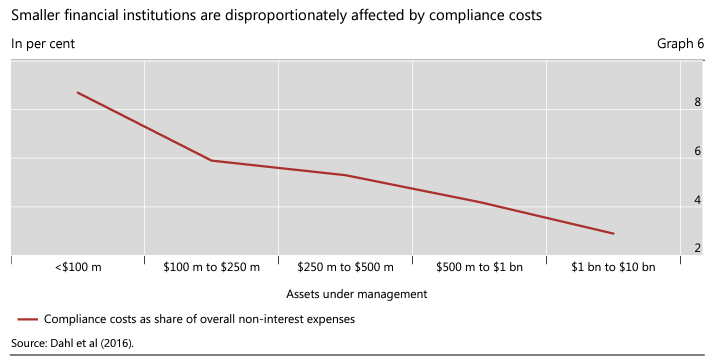Embedded Supervision: Is it a Ray of Hope for Stablecoin Regulation?

nce between complaints that go unanswered and those that are answered over a long period of time. Because if the current problem is remedied at that time, the users who have suffered will be highly pleased. As a consequence, the fact that relevant organizations gain confidence in this manner boosts the chances of politicians receiving votes.
This crisis created by the Terra network has created many victims in terms of being a major crisis, just as described above. Regulators and politicians in practically every country where cryptocurrencies are a hot topic have begun to make statements about the regulation of stable currencies and/or the DeFi sector one after the other. Because the developments in the United States and the European Union, which are at the top of the economic size and development index, and the words of politicians in these countries are so important, it is critical to question whether the assertions are based on a serious study. For this reason, in this article, we will analyze international studies in the field of regulation, notably in the EU. To give a little hint, given the developed countries, except the US, it is difficult to say that the EU and international organizations have reached a noteworthy point of stable money and in the field of DeFi. The explanations given regarding the DeFi regulation, in particular, might be argued to be intended at comforting the victims.
Responsibility has been Delegated to the FSB
The request for international acceptance of the regulations to be made especially on cryptocurrency regulation is a joint request of the authorities. Otherwise, it is thought that country-based decisions will not affect the general sector, which will make it difficult to violate and follow the regulations. One of the German Central Bank authorities, Joachim Wuermeling, stated that “digital has no borders” in terms of DeFi, and he highlights very well that traditional methods cannot be used.
The G7 economy ministers and central bank governors gathered in Germany last May and assigned the FSB (Financial Stability Board) for supervising cryptocurrency and, in particular, the regulation of stable currencies. There is no question that a regulation published by the FSB will be widely recognized since it includes all G20 countries, the European Commission, and FSF members. Furthermore, the FSB has already published reports on concerns that stable currencies and the DeFi industry could jeopardize global stability, and it took on a similar regulatory duty in October 2021. So the process actually started before the G7 meeting.
So, what is the FSB’s currently highlighted work on regulation? Raphael Auer, who is also chairman of the innovation department of BIS, a Basel-based organization that sets international banking standards, focuses on an infrastructure system and associated principles called Embedded Supervision by FSB, an another Basel-based organization. Let’s look at the details and possible positive and negative returns of this study in partnership with BIS and FSB.
Embedded Supervision
Approach Difference
Before going into the system’s specifics, it’s important to keep in mind that this research has a fairly favorable outlook on the regulation issue. First of all, this research is based on the notion of ‘technological neutrality’ which is particularly important when governing a technological area. In other words, it depends on the principle that no technological field is more encouraged or prevented than another through regulations.
While regulators work to adapt cryptocurrencies to existing principles, this study argues that technologies like blockchain and DLT, which have become popular with cryptocurrencies, should be used, and that regulations can be carried out in accordance with the sector using these technologies. Since this study belongs to organizations such as FSB and BIS, the adoption of such an approach to cryptocurrencies is extremely positive.
Principles
With a code update to the distributed ledger system (DLT) used by DeFi platforms, this system, which means an automatic control mechanism embedded in the network, includes an automatic recording of each transaction in the network, categorization, and access to this information by the authorities at any time. In other words, it can be said that the system will act as a monitor.
This system, which will continuously monitor the network and platforms, ensures that the regulators be hand in glove with blockchain and DLT systems. In order for official organizations to connect directly with these infrastructures, the accuracy of the data obtained through this mechanism should be legally recognized. For this purpose, 3 main principles have been determined for the system.
- On their own, the cryptographic data validation algorithms utilized in DLT-based DeFi platforms are insufficient. It is imperative that the platforms are positioned on a legal basis in order for the system to be integrated into the platform.
- In order for the system to be integrated into the network, the security level in the network in question must be high. It is stated that constructions (such as Bitcoin, and Ethereum) that miners or nodes cannot profit from their malicious behavior will be especially preferred.
- Because the expenses of implementing regulations can be quite high for businesses at times, it is aimed that this technology will automate the process and lower the expenditures.
Let’s take a look at what these principles mean…
- The first clause states that cryptographic approval mechanisms can only be accepted by the system when combined with legal infrastructures. For example, an asset-based token is being said to comply with this definition. In other words, because it represents a real asset, a synthetic token representing a stock or another token designed for real estate can both be tailored to legal requirements and traded through cryptographic verification.
It is clear, especially in this article, that the FSB’s work cannot be applied to the whole DeFi sector. Because it is understood that cryptocurrencies like BTC and ETH, which are not based on a real asset and create their own values exclusively through cryptographic verifications, will not be suited for the Embedded Supervision system. It can be said that this study is more suitable for DeFi platforms where cryptocurrencies called synthetic tokens, which represent the price of an asset, are traded. - Assuming that the legal infrastructure is provided, another main criterion is that miners/nodes do not profit from attacks on the network. Networks such as Bitcoin and Ethereum have long owed their ability to operate successfully to economic incentive mechanisms. Any malicious attempt on these networks would result in huge expenses rather than revenues, which would not make sense. In this study, the importance of supporting the networks where the system will be integrated with strong economic incentive mechanisms is mentioned.
- As a result of regulatory decisions, enterprises are obliged to establish the necessary infrastructures. Otherwise, they run the risk of being punished. The establishment of these infrastructures also means that a new and continuous cost item is dumped on businesses. Since Embedded Supervision will work on its own, such as smart contracts, it is aimed that each business will adapt to the regulation with small preparations, and thus, it is aimed to reduce costs.

The graph on the left depicts the change in the ratio of regulatory charges to total company costs from 2016 to 2018. Although the number of businesses with regulatory costs of 4% or more has decreased over the last two years, there is a stable aggregation between 1–4%.
When the graph on the right is examined, it is seen that the regulatory costs are not limited to companies, but that the FED and ECB also have similar problems. While the FED spends over 1.8 billion dollars per year on regulatory infrastructure, the ECB spends around 500 million dollars.
Mechanism of Operation
The following scheme is quite useful to summarize the operation of the system.

- On the left side of the image, the aggregation of the tokenization process is represented. Instead of cryptocurrencies like BTC and ETH, tokens should be thought of as tokens that represent a real asset, as previously stated.
- Transactions from the left side category are divided into 3 main categories in the middle section of the image.
- The data here, which is clustered by operations classes, passes through the controller that we see with the purple dashed line. The auditor here is the Embedded Supervision system itself. In other words, each transaction is definitely recorded by the supervisor before it is finalized and divided into more detailed categories.
- The rightmost categories include various organizations such as tax agency, statistical agency, and exchange commissions. These organizations can approve transactions on the network with a digital signature and time stamp to finalize the process.
- Because it is not safe for all information inside the transaction public, the transaction information is kept private, and only the relevant organization has access to the transaction’s specifics. In other words, Embedded Supervision uses an infrastructure in which the substance of transaction is hidden but the data’s accuracy can be verified using a framework similar to the Zero Knowledge (ZK) protocol, which is widely used on the Ethereum network.
- For example, information about a bank loan should remain confidential between the customer and the bank. Therefore, none of the various organizations shown on the far right can see the content of the transaction. Only the digital key owned by the bank can see the information in that data.
The most significant advantage of this system is that it allows official organizations to directly participate in a common DLT infrastructure. Even if a token is based on an asset that has already been used, it will be stuck in the bureaucratic procedures. When a token representing a house is sold, for example, the traditional process for making a formal change in the title deed must be followed. Cryptographic data transmissions are not accepted by official creditors due to a lack of legal and technical infrastructure. If it had, the title deed of the house could have been transferred to the new token holder as soon as the token was transferred. Embedded Supervision is uniquely qualified to address this issue. The fact that official organizations can participate directly in the network ensures that data in the network comes directly from official organizations, that is, the data’s source, and allows official organizations to identify data on the network. The ecosystem can be developed in this way by quickly overcoming bureaucratic procedures through tokenization.
Differentiation of Concepts
The concept of decentralization has become a concept almost entirely identified with the cryptocurrency marketplace. In the Embedded Supervision study, no negative opinion is reported against decentralization. However, at this point, the first clause among the principles shows that there is a difference between the decentralization meant by the FSB and the decentralization in the cryptocurrency market.
Given that one of the necessary prerequisites is for the system to be legally settled to a clear infrastructure, the decentralization referred to by Embedded Supervision only refers to a technical decentralization. In other words, the number of miners/nodes in the network may be high, and they may be split across the region, ensuring that the network functions without being dependent on anyone. However, these miners/nodes must not be anonymous in order for there to be no legal gap. In such a case, decentralization is only provided technically, and it is not anonymous as it is in the cryptocurrency market. In this case, the possibility of the Embedded Supervision system regulating the DeFi platforms working on decentralize blockchains suchs as Ethereum decreases considerably. As a result, this report, which politicians or authorities point to when discussing DeFi legislation, isn’t actually a DeFi regulation. Since popular DeFi platforms are based on anonymity, how they will be encouraged to connect with Embedded Supervision is a big question mark.
Stable currencies
While it appears that Embedded Supervision will have difficulties with anonymous blockchains due to the legal framework required, this does not appear to be the case with stable currencies. If necessary by law, stable currency issuers like Tether and Circle, which already operate centrally and strive to comply with all kinds of regulations, can be integrated to the Embedded Supervision system. In this case, the transactions of stable currencies such as USDT and USDC and the amount in their reserves can be viewed instantly by the regulator.
Considering the public’s opinion of stable currencies following the UST, it’s reasonable to assume that this method will be used mostly for stable currencies rather than DeFi. In terms of the applicability of the regulation, stable currencies seem to be more suitable for Embedded Supervision.
Pilot Projects
The official gazette of the European Union dated 24 February 2022 states that pilot studies have been carried out on Embedded Supervision.

In comparison to other regions, the EU may have a higher need for DeFi and stable money regulations. Supporting innovative sectors is vital for the EU, which has a well-developed, skilled workforce but also an elderly population. As fintech allows young and talented people to come to the EU, it is important to protect the present fintech sector while also bringing in new innovative areas like cryptocurrencies.

Again, going back to the issue of the cost of regulation, according to the graph above, the cost of regulation for companies managing an asset of USD 100 million or less is around 8%, while 1 billion and 10 billion USD, this rate is around 2%. Therefore, if regulations, which are a much more costly item for small businesses, can be reduced to low costs using systems like Embedded Supervision, significant support for the EU’s economic sustainability can be created.
— — — — — — —
As a result, there is not yet a suitable study for international regulation to work fully, especially in the field of DeFi. However, since Embedded Supervision is suitable for stable currencies, a regulation decision in this area can be made more quickly. The biggest achievement in this system is clearly the integration of official organizations into DLT-based networks. If this solution is adopted, substantial progress in the field of tokenization will be made.
Prepared By: Berkay Aybey
The opinions and comments expressed here belong to BV Crypto. BV Crypto cannot be held responsible for any financial transactions made on the basis of this post. Every investment and trading move involves risk. When making your decision, you should do your own research.